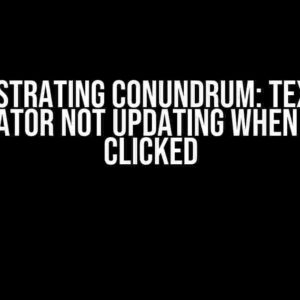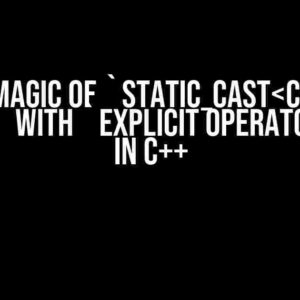The Power of Unicode Categories in Antlr4
If you’re working with Antlr4, you’re likely familiar with the incredible power of Unicode categories. These categories allow you to match characters based on their properties, such as alphabetic characters, digits, or punctuation marks. One of the most versatile and widely used categories is the `\p{..}` syntax, which enables you to match characters belonging to a specific Unicode property or category.
The Problem: Excluding Specific Characters
But what if you need to exclude specific characters from a Unicode category? For instance, you might want to match all alphabetic characters except for a few special cases, like the Turkish dotless ‘ı’ (ı) or the Cyrillic letter ‘Ґ’ (ґ). This is where things get tricky, as the `\p{..}` syntax doesn’t provide an obvious way to exclude specific characters.
The Solution: Using Character Ranges and Negation
Fear not, dear Antlr4 enthusiasts! We’ve got a solution that’ll help you master the art of excluding specific characters from a Unicode category.
Method 1: Character Ranges
One approach is to use character ranges to explicitly define the characters you want to match, while omitting the ones you want to exclude. This method is particularly useful when you have a small set of characters to exclude.
lexer grammar MyLexer;
ALPHABETIC:
[\u0041-\u005A\u0061-\u007A\u00C0-\u00C5\u00C7-\u00CE\u00CF-\u00D6\u00D8-\u00F6\u00F8-\u00FF]
;
In this example, we define an `ALPHABETIC` lexer rule that matches all alphabetic characters, except for the Turkish dotless ‘ı’ (ı) and the Cyrillic letter ‘Ґ’ (ґ). We achieve this by specifying a range of characters using Unicode code points. Note that this method can become cumbersome when dealing with a large number of characters to exclude.
Method 2: Negation with the `~` Operator
A more elegant solution is to use the `~` operator, which allows you to negate a character set. This approach is perfect for excluding specific characters from a Unicode category.
lexer grammar MyLexer;
ALPHABETIC:
[\p{Alpha}~[ıҐ]]
;
In this example, we define an `ALPHABETIC` lexer rule that matches all alphabetic characters (`\p{Alpha}`) except for the Turkish dotless ‘ı’ (ı) and the Cyrillic letter ‘Ґ’ (ґ), which are explicitly excluded using the `~` operator.
Tips and Variations
Combining Unicode Categories and Character Ranges
You can combine Unicode categories and character ranges to create more complex matching rules. This allows you to match a broad range of characters while excluding specific ones.
lexer grammar MyLexer;
ALPHABETIC:
[\p{Alpha}~[ıҐ]][\u0100-\u017F]
;
In this example, we match all alphabetic characters (`\p{Alpha}`) except for the Turkish dotless ‘ı’ (ı) and the Cyrillic letter ‘Ґ’ (ґ), and then add the range of characters from U+0100 to U+017F to include additional characters.
Excluding Multiple Characters with the `~` Operator
When excluding multiple characters, you can separate them using the `~` operator.
lexer grammar MyLexer;
ALPHABETIC:
[\p{Alpha}~[ı~Ґ~ç~ö]]
;
In this example, we exclude the Turkish dotless ‘ı’ (ı), the Cyrillic letter ‘Ґ’ (ґ), the Latin letter ‘ç’ (ç), and the Latin letter ‘ö’ (ö) from the `ALPHABETIC` lexer rule.
Conclusion
Excluding specific characters from a Unicode category in Antlr4 is a crucial skill to master, and with these methods, you’re now equipped to tackle even the most complex requirements. Whether you choose to use character ranges or negation with the `~` operator, the key is to understand how to combine these techniques to achieve the desired matching behavior.
Best Practices
When working with Unicode categories and character ranges, keep the following best practices in mind:
- Use Unicode categories (`\p{..}`) whenever possible to ensure broad coverage of characters.
- Use character ranges to define explicit character sets when necessary.
- Employ negation with the `~` operator to exclude specific characters from a Unicode category.
- Combine Unicode categories and character ranges to create complex matching rules.
FAQ
Q: What is the difference between `\p{Alpha}` and `\p{Letter}`?
A: `\p{Alpha}` matches alphabetic characters, while `\p{Letter}` matches characters that are considered letters in Unicode, including alphabetic and ideographic characters.
Q: Can I use the `~` operator to exclude characters from a character range?
A: Yes, you can use the `~` operator to exclude characters from a character range. For example, `[\u0041-\u005A~[Q]]` would match all uppercase letters from A to Z, excluding the letter Q.
Q: Are there any performance implications when using the `~` operator?
A: The `~` operator can have a slight performance impact, as it requires the lexer to perform additional checks. However, this impact is usually negligible, and the benefits of using the `~` operator often outweigh the costs.
| Method | Description |
|---|---|
| Character Ranges | Define explicit character sets using Unicode code points. |
| Negation with `~` Operator | Exclude specific characters from a Unicode category using the `~` operator. |
With these methods and best practices, you’re ready to tackle even the most complex Unicode-related challenges in Antlr4. Happy parsing!
Frequently Asked Question
Are you stuck trying to exclude specific characters from a `\p{..}` unicode set in an Antlr4 Lexer? Don’t worry, we’ve got you covered! Here are some frequently asked questions to help you through this hurdle.
How do I specify the characters I want to exclude from the unicode set?
To exclude specific characters from a `\p{..}` unicode set, you can use the `~` character followed by the characters you want to exclude. For example, `\p{L}~[a-zA-Z]` would match any letter except for `a-z` and `A-Z`.
Can I use ranges to exclude characters from the unicode set?
Yes, you can use ranges to exclude characters from the unicode set. For example, `\p{L}~[a-z]|[A-Z]` would exclude all lowercase and uppercase letters from the set of all letters.
How do I exclude a set of characters from a specific unicode category?
To exclude a set of characters from a specific unicode category, you can use the `~` character followed by the category specifier and the characters you want to exclude. For example, `\p{Lu}~[À-Ü]` would match any uppercase letter except for those in the range `À-Ü`.
Can I use the NOT operator to exclude characters from the unicode set?
Yes, you can use the NOT operator (`^`) to exclude characters from the unicode set. For example, `[^a-zA-Z]` would match any character that is not a letter.
Are there any limitations to excluding characters from a unicode set in Antlr4?
Yes, there are some limitations to excluding characters from a unicode set in Antlr4. For example, you cannot use the `~` character to exclude characters from a set that is not a unicode property or category. Additionally, the `^` character can only be used at the start of the set.




